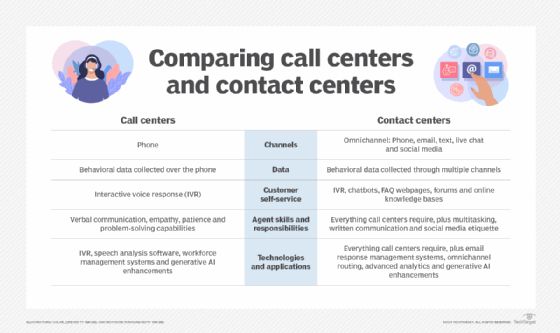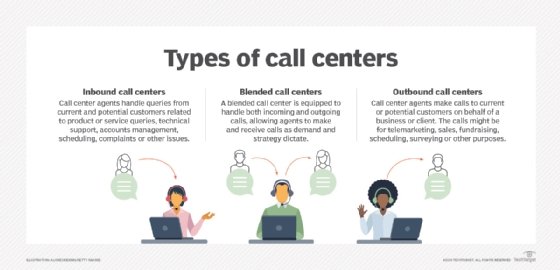What is a call center? Everything you need to know
A call center is a centralized department of customer service professionals who handle inbound and outbound calls from current and potential customers. Call centers are located either within an organization or are outsourced to another company that specializes in handling calls.
Call centers must maintain a high level of service to match customers' expectations. Call center agents must also be knowledgeable, helpful and patient with customers.
Call centers play a vital role in creating a good customer experience (CX), as many focus on customer satisfaction and support while also potentially increasing the number of leads and sales.
What is the difference between a call center and a contact center?
Although the terms are sometimes used interchangeably, the terms call center and contact center refer to different technologies and ways of communicating.
Traditional call centers focus on one communication channel: the telephone. Contact centers, on the other hand, provide support using multiple traditional and digital channels, such as email, telephone, web chats, social media and applications. A contact center can also include one or more call centers.
Contact centers provide omnichannel support, assisting customers on whichever channel or device they use. Whether an organization chooses a call center or contact center depends on its customer base, products and services; the channels on which it provides customer support; and the structure of its support team.

How do call centers work?
Online merchants, telemarketing companies, help desks, mail-order organizations, polling services, charities and any large organization that uses the telephone to sell products or offer services use call centers. These organizations also use call centers to enhance CX.
Call centers handle both inbound calls from customers and outbound calls, which the agent makes on behalf of the organization or client. A basic inbound call center process starts with the customer making the initial call. The customer typically interacts with an interactive voice response (IVR) system, which is an automated system that prompts the caller with several options. These prompts determine where the call should be routed. Once the caller is routed to the right agent, the call center agent can then address and assist with the caller's query. The call is typically recorded to improve customer service interactions.
Importance of call centers
Customers have high expectations for customer service. They want their issues addressed and handled quickly and efficiently. Organizations must have representatives available when customers call for service or support, and those with call centers can more effectively assist customers in need. Call centers can make an organization available 24/7 or during a time window that matches customer expectations.
Customer phone calls have value beyond customer service. With some products or services, phone calls are the only interactions organizations have with customers. Therefore, it's the only opportunity to personally connect with customers.
Types of call centers
The three most common types of call centers are inbound, outbound and blended call centers.
Inbound call center. Typically, these call centers handle a considerable volume of calls simultaneously and then screen, forward and log the calls. An IVR system can answer calls and use speech recognition technology to address customer queries with an automated message or route calls to the appropriate call center agents or recipients through an automated call distributor (ACD).
Agents in an inbound call center might handle calls from current or potential customers regarding account management, scheduling, technical support, complaints, queries about products or services, or intent to purchase from the organization.
Outbound call center. In these call centers, an agent makes calls on behalf of the organization or client for tasks including lead generation, telemarketing, customer retention, fundraising, surveying, collecting debts or scheduling appointments. To maximize efficiencies, an automated dialer can make the calls and then transfer them to an available agent using an IVR system after the caller connects. Outbound call centers must ensure compliance with the National Do Not Call Registry, a list to which citizens can add their phone numbers to avoid unwanted solicitation calls.
Blended call center. This type of call center handles both inbound and outbound calls.

Beyond inbound, outbound and blended, further classifications of call centers include the following:
- In-house call center. The organization owns and runs its call center as well as hires its agents.
- Outsourced call center. The organization hires a third party to handle calls on its behalf, generally to remove the burden of hiring and training call center agents as well as investing in and updating call center technology, which can reduce operating costs.
- Offshore call center. The organization outsources its operations to a company in another country, often to save money on wages and provide services around the clock. Drawbacks to an offshore call center include reduced customer satisfaction due to language issues as well as a lack of knowledge about the organization, product or service due to distance.
- Virtual call center. The organization employs geographically dispersed agents who answer calls using cloud call center technology. In a virtual call center, call center agents work either in smaller groups in different offices or remotely in their own homes.
Call center teams and structure
Many different roles make up call center teams:
- Call center agents. Agents are the key point of contact between an organization and its customers, as agents talk directly with customers and handle their calls. Depending on the type of call center, agents might handle either outgoing or incoming calls. Call center agents typically have customer service skills, are knowledgeable about the organization and are creative problem-solvers.
- Team leaders. Many call centers split agents into smaller groups for easier management. Team leaders provide call center management, helping call center agents de-escalate conversations, solve issues, or answer questions from customers or the agents.
- Call center directors. While team leaders run smaller teams, call center directors run operations and ensure everything runs smoothly. Directors, or managers, set the metrics and expectations for agent performance to ensure they meet the standards for customer expectations and keep the center running smoothly.
- Quality assurance team. Quality assurance ensures products or services meet specific requirements, and QA teams put this into practice. These teams can monitor and evaluate agent phone calls in call centers to ensure the call quality and CX are up to the center's standards. In some cases, call center directors run the QA checks.
- IT personnel. IT professionals are critical to call centers, especially those with remote operations. While IT personnel aren't exclusive to call centers, they ensure agents' technology and tools are up to date to keep the call center running smoothly.
Call center technology
Call centers, at their cores, require two key pieces of technology: computers and headsets. Call center agents need access to computers and reliable headsets to make and receive calls so their voices sound clear and it's easy for customers to understand.
Remote call center agents might also require enhanced internet access to access their organizations' call center software reliably, so organizations might want to invest in home networking equipment for remote agents.
Other critical call center technology and software include the following:
- Call management software, including ACD technology.
- Call recording and monitoring software.
- Customer profiles.
- Speech analytics tools.
- Workforce management software.
- Customer relationship management (CRM) systems.
- IVR software.
- Outbound dialers.
- Chatbot or virtual assistant technology.
Examples of call centers across industries
Call centers can benefit any industry that interacts with customers over the phone. Examples include the following:
- Airlines. Customers call airline toll-free numbers to engage with IVR menus or speak to customer service agents. Customers can check flight statuses, obtain flight details and check frequent flyer mileage balances. In addition, flyers can speak to customer service agents to rebook a flight. When weather conditions, such as a major winter storm, cause flight delays or cancellations, airlines can quickly respond to customer needs.
- Financial. Customers call financial institutions to ask about checking account balances, reporting lost or stolen cards, or disputing charges. Call centers in the finance sector can also help customers update account information, apply for loans, and answer questions about products and services.
- Healthcare. Customers call healthcare providers to make, change or confirm appointments as well as to ask physicians questions. When a medical emergency arises off-hours, healthcare providers can use outsourced call centers to receive calls and route them to an on-call physician.
- Retail. Customers call retail businesses for assistance before, during or after purchases. Before or during purchase, a customer might ask a customer service agent about shipping details or the retailer's return policy. After a purchase, customers might call to report a missing item or request a return.
How is call center success measured?
Organizations often monitor key performance indicators (KPIs) to measure the success and efficiency of call centers and agents. The KPIs vary depending on the center's function. An outbound call center might measure cost per call, revenue earned, total calls made and tasks completed. An inbound call center might track metrics including first call resolution (FCR), average wait time and abandoned call rates.
Other performance metrics often tracked in call centers include the following:
- Average time in queue. This measures how long a caller was in the call queue.
- Average handle time. This measures how long it took for the agent to handle the call.
- Customer satisfaction score. CSAT measures how satisfied a customer is with the service they received.
In addition, organizations often use speech analytics software to monitor and analyze call center agent performance. It can identify areas in which agents require more knowledge and training, which can improve call handling times and FCR.
Are call centers obsolete?
Call centers have a single focus: provide callers with quality service over the phone. In some cases, organizations have evolved their call centers into contact centers, as many customers expect some form of omnichannel support. Contact centers enable customers and potential leads to communicate through whichever platform they feel most comfortable with. Contact center agents can also interact with customers across these different channels using a single platform, including phone systems.
Contact centers can also handle more complex queries than call centers. Contact centers typically have access to multimedia support, real-time collaboration tools, and CRM and knowledgebase data. They can also escalate queries across channels.
Call centers aren't entirely obsolete, however. Some businesses might only need phone support for specific needs, such as telemarketing, for example. Smaller, more niche businesses or demographics might only require call centers as well. Call centers are also still useful for relatively straightforward queries and for businesses with a smaller service budget.
Even though contact centers are much more flexible than call centers, they both still serve a purpose. Learn more about how call centers compare and differ to contact centers.






